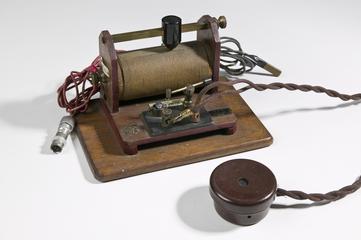Rexophone crystal set with two pairs of Telefunken headphones (out of three), 1923-1930
Rexophone crystal set manufactured by Morch Borthers Limited, London, 1924-1930. Complete with 3 pairs of headphones manufactuered by Telefunken, Germany, 1923-1930. The radio set used tapped inductance tuning and came in a mahogany cabinet with lid, a ‘Xylonite’ control panel available in different colours with imitation marble control knobs and nickel-plated fittings. Gold-plated fittings were supplied for an extra 5/-. It came with terminals for two pairs of headphones and had operating instructions inside the lid. The detector was twin-enclosed cats whiskers / galena detectors with a selector switch on the panel.
More
The Rexophone crystal set was first on sale from 1923 and was sold by Morch Brothers Limited, 35 Tresham Avenue, London, E5. It was sold for £2 5s 0d including the long-wave coil which could be used to receive the Paris time signals on 2,600 metres.
- Materials:
- mahogany , metal (unknown) , plastic (unidentified) , paint and felt
- Object Number:
- 1971-364/1
- type:
- radio receiver
- Image ©
- The Board of Trustees of the Science Museum












